
Books on Happiness / The Definitive Book Of Body Language- 2 students
.pdf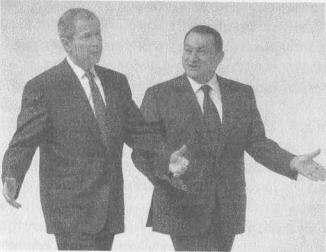
Mirroring - How We Build Rapport
Mirroring the other person's body language and appearance shows a united front and doesn't let either get one-up on the other
Mirroring on a Cellular Level
American heart surgeon, Dr Memhet Oz, reported some remarkable findings from heart recipients. He found that, as with most other body organs, the heart appears to retain cellular memories, and this allows some patients to experience some of the emotions experienced by the heart donor. Even more remarkably, he found some recipients also assume the same gestures and posture of the donor even though they have never seen the donor. His conclusion was that it appears that the heart cells instruct the recipient's brains to take on the donor's body language. Conversely, people suffering from disorders such as autism have no ability to mirror or match the behaviour of others, which makes it difficult for two-way communication with others. The same goes for drunk people whose gestures are out of sync with their words, making it impossible for any mirroring to occur.
Because of the phenomenon of cause and effect, if you intentionally assume certain body language positions you will begin to experience the emotions associated with those gestures. For example, if you feel confident, you may
253
The Definitive Book of Body Language
unconsciously assume the Steeple gesture to reflect your confidence, but if you intentionally Steeple you will not only begin to feel more confident, others will perceive that you're confident. This, then, becomes a powerful way to create a rapport with others by intentionally matching their body language and posture.
Mirroring Differences Between Men and
Women
Geoffrey Beattie, at the University of Manchester, found that a woman is instinctively four times more likely to mirror another woman than a man is to mirror another man. He also found that women mirror men's body language too, but men are reluctant to mirror a woman's gestures or posture - unless he is in courtship mode.
When a woman says she can 'see' that someone doesn't agree with the group opinion she is actually 'seeing' the disagreement. She's picked up that someone's body language is out of sync with group opinion and they are showing their disagreement by not mirroring the group's body language. How women can 'see' disagreement, anger, lying or feeling hurt has always been a source of amazement to most men. It's because most men's brains are simply not well equipped to read the fine detail of others' body language and don't consciously notice mirroring discrepancies.
As we said in our book Why Men Don't Listen & Women
Can't Read Maps (Orion), men and women's brains are programmed differently to express emotions through facial expressions and body language. Typically, a woman can use an average of six main facial expressions in a ten-second listening period to reflect and then feed back the speaker's emotions. Her face will mirror the emotions being expressed by the speaker. To someone watching, it can look as if the events being discussed are happening to both women.
A woman reads the meaning of what is being said through
2 5 4
Mirroring — How We Build Rapport
the speaker's voice tone and his emotional condition through his body language. This is exactly what a man needs to do to capture a woman's attention and to keep her interested and listening. Most men are daunted by the prospect of using facial feedback while listening, but it pays big dividends for the man who becomes good at it.
Some men say 'She'll think I'm effeminate!', but research with these techniques shows that when a man mirrors a woman's facial expressions as she talks she will describe him as caring, intelligent, interesting and attractive.
Men, on the other hand, can make fewer than a third of the facial expressions a woman can make. Men usually hold expressionless faces, especially in public, because of the evolutionary need to withhold emotion to stave off possible attack from strangers and to appear to be in control of their emotions. This is why most men look as if they are statues when they listen.
The emotionless mask that men wear while listening allows them to feel in control of the situation, but does not mean men don't experience emotions. Brain scans reveal that men can feel emotion as strongly as women, but avoid showing it publicly.
What to Do About It if You're Female
The key to mirroring a man's behaviour is in understanding that he doesn't use his face to signal his attitudes - he uses his body. Most women find it difficult to mirror an expressionless man but with males this is not required. If you're a woman, it means that you need to reduce your facial expressions so that you don't come across as overwhelming or intimidating. Most importantly, don't mirror what you think he might be feeling. That can be disastrous if you've got it wrong and you may be described as 'dizzy' or 'scatterbrained'. Women in business who listen with a more serious face are described by men as more intelligent, astute and sensible.
2 5 5

The Definitive Book of Body Language
When Men and Women Start to Look Alike
When two people live together for a long time and have a good working relationship, they often begin to look alike. This is because they are constantly mirroring each other's facial expressions, which, over time, builds muscle definition in the same areas of the face. Even couples who don't look facially similar can appear similar in a photograph because they use the same smile.
The Beckhams don't look at |
Forty years of mirroring - |
all alike until they smile |
the Beckhams at retirement |
|
with their dog, Spot |
In 2000, psychologist Dr John Gottman of the University of Washington, Seattle, and his colleagues, discovered that marriages are more likely to fail when one partner not only does not mirror the other's expressions of happiness, but instead shows expressions of contempt. Instead, this opposite behaviour affects the smiling partner, even when they are not consciously aware of what is happening.
Do We Resemble Our Pets?
You can also see mirroring occur in the pets some people choose. Without realising it, we unconsciously tend to favour pets that
256
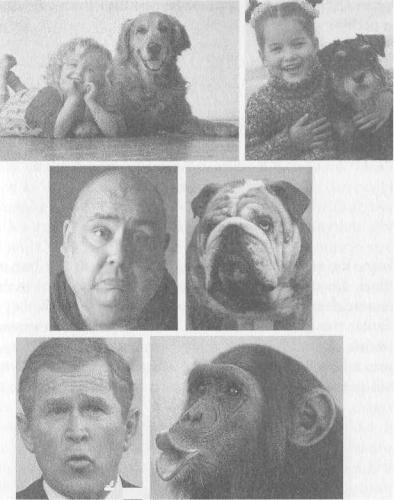
Mirroring - How We Build Rapport
physically resemble us, or that appear to reflect our attitudes. To demonstrate the point, here are a few examples:
Do we choose pets that resemble us?
Monkey See, Monkey Do
The next time you attend a social function or go to a place where people meet and interact, notice the number of people who have taken the identical gestures and posture of the person with whom they're talking. Mirroring is the way one
2 5 7

The Definitive Book of Body Language
person tells another that he is in agreement with his ideas and attitudes. One is non-verbally saying to the other, 'As you can see, I think the same as you.' The person with the highest status often makes the first moves and the others copy, usually in pecking order.
Thinking alike
Take, for example, the two men standing at the bar in the above illustration. They are mirroring so it's reasonable to assume that they are discussing a topic on which they have similar thoughts and feelings. If one man uses an evaluation gesture or stands on the other foot, the other will copy. One puts a hand in his pocket, the other copies again. Mirroring will continue for as long as the two are in agreement.
Even when Presidents Bush and Chirac disagree verbally, they still usually mirror each other - this shows they have mutual respect
2 58
Mirroring - How We Build Rapport
Mirroring happens among friends or between people of the same status and it is common to see married couples walk, stand, sit and move in identical ways. Albert Scheflen found that people who are strangers studiously avoid holding mirror positions.
Matching Voices
Intonation, voice inflection, speed of speaking and even accents also synchronise during the mirroring process to further establish mutual attitudes and build rapport. This is known as 'pacing' and it can almost seem as if the two people are singing in tune. You will often see a speaker beating time with his hands while the listener matches the rhythm with head nods. As a relationship grows over time, the mirroring of the main body language positions becomes less as each person begins to anticipate the other's attitudes, and vocal pacing with the other person becomes a main medium for maintaining rapport.
Never speak at a faster rate than the other person. Studies reveal that others describe feeling 'pressured' when someone speaks more quickly than they do. A person's speed of speech shows the rate at which their brain can consciously analyse information. Speak at the same rate or slightly slower than the other person and mirror their inflection and intonation. Pacing is critical when attempting to make appointments by telephone because voice is your only communication medium.
Intentionally Creating Rapport
The significance of mirroring is one of the most important body language lessons you can learn because it's a clear way in which others tell us that they agree with us or like us. It is also a way for us to tell others that we like them, by simply mirroring their body language.
2 5 9
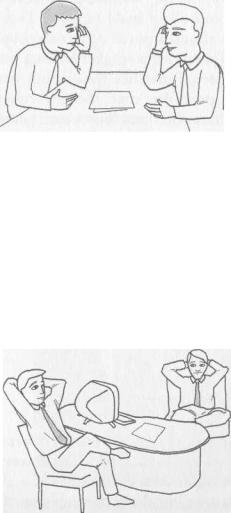
The Definitive Book of Body Language
If a boss wants to develop a rapport and create a relaxed atmosphere with a nervous employee, he could copy the employee's posture to achieve this end. Similarly, an up-and- coming employee may be seen copying his boss's gestures in an attempt to show agreement when the boss is giving his opinion. Using this knowledge, it is possible to influence others by mirroring their positive gestures and posture. This has the effect of putting the other person in a receptive and relaxed frame of mind, because he can 'see' that you understand his point of view.
Mirroring the other person's body language to gain acceptance
Before you mirror someone's body language, however, you must take into consideration your relationship with that person. Let's say, for example, the junior employee of a corporation has asked for a pay rise and is called into the manager's office. The employee enters the manager's office, the manager asks him to sit down and assumes the Catapult with a Figure-Four showing the employee a superior, dominant attitude. But what would happen if the junior then copied the manager's dominant body language while discussing the potential salary rise?
A boss would perceive a subordinate's mirroring behaviour as arrogance
260
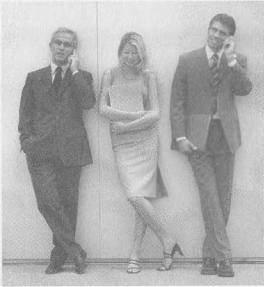
Mirroring - How We Build Rapport
Even if the employee's talk was on a subordinate level, the manager could feel affronted by the employee's body language and his job could be in jeopardy. Mirroring is also effective for intimidating or disarming 'superior' types who try to take control. Accountants, lawyers and managers are notorious for using superiority body language clusters around people they consider inferior. By mirroring, you can disconcert them and force a change of position. But never do it to the boss.
They have the same posture and body language and the close distance between them shows they are friends going about business in the same way with similar goals.
Who Mirrors Whom?
Research shows that when the leader of a group assumes certain gestures and positions, subordinates will copy, usually in pecking order. Leaders also tend to be the first of a group to walk through a doorway and they like to sit on the end of a sofa, table or bench seat rather than in the centre. When a group of executives walks into a room, the person with the highest status usually goes first. When executives are seated in the boardroom,
261
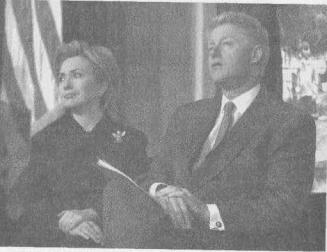
The Definitive Book of Body Language
the boss usually sits at the head of the table, often furthest from the door. If the boss sits in the Catapult, his subordinates are likely to copy in order of their importance within the group You can see this in a meeting where people 'take sides' with others by mirroring their body language. This lets you see who will vote with you and who will vote against you.
Mirroring is a good strategy to use if you are part of a presentation team. Decide, in advance, that when the team spokesperson makes a gesture or takes a posture when speaking, the entire team will mirror. This not only gives your team the powerful appearance of being cohesive, it can frighten the hell out of competitors who suspect something is up, even though they can't quite figure out what it is.
Bill Clinton may have been the world's most powerful man but when Hillary gestured, he copied - and when
they walk hand-in-hand, she often has the front-hold position
When presenting ideas, products and services to couples, watching who mirrors whom reveals where the ultimate power or final decision-making ability lies. If the woman makes the initial movements, however small, such as crossing her feet, lacing her fingers or using a Critical Evaluation cluster and the man copies, there is little point in asking him for a decision - he doesn't have the authority to make it.
262
